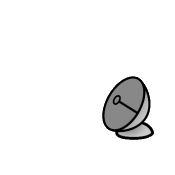
The SiDS (Simple Downlink Share) interface is a simple and straightforward standard which can be used to allow any receving station to forward data packets to a mission control center located elsewhere on the globe. It was introduced and first used by the University of Würzburg, for the UWE-3 mission. The whole standard is documented in this PDF. To make life easier for the radio-amateurs wishing to contribute to the PicSat mission, and in the hope of reinforcing even more this collaboration, we decided to implement a Web server complying with this amateur standard.
In its specification, the SiDS system does not really include any way to properly authenticate the user when sending the data. It relies mainly on the honesty of the users.
In the PicSat SiDS system, the "source" of the request (see parameter list below) is checked against the list of users registered on this Website. So if you want to send us your received data frames via the SiDS system, you must first create an account on the website. If you have a callsign, you should use it as the "source" parameter in your requests. If you do not have a callsign, you may use your username instead.
When you register on the website, you will have the possibility to open/close your SiDS access on your profile page. By default, the access if closed, so you must first open it before sending data. If you close your access, any request sent using your username/callsign will be rejected by the server.
Again, the callsign/username is used to allocate the packet to the user, and there is no way for us to authenticate the user. Keep that in mind when opening your SiDS access!
The base address of the server is the following:
https://picsat.obspm.fr/sids/reportframe?
SiDS requests are sent as HTTP POST requests to this base address, with all the required and optional parameters:
https://picsat.obspm.fr/sids/reportframe?noradID=100&source=F4HZG×tamp=2018-01-12T09:00:00Z&frame=FE DC BA 98 76 54 32 10&locator=latlong&longitude=5E&latitude=45N
The required and optional parameters are described in the SiDS standard (see downloadable PDF in the above section), reproduced below for the reader's convenience.
| Parameter | Required | Type | Description | Example |
|---|---|---|---|---|
| noradID | True | int | Norad ID of the spacecraft | 43131 |
| source | True | str | Callsign or user name of the receiver | F4HZG, or Mathias Nowak |
| timestamp | True | str | UTC timestamp (see ISO 8601) | 2018-01-24T23:42:46Z |
| frame | True | str | The received data, in hexadecimal string (AX.25 packet with or without KISS 'C0 00 .. C0'. Whitespaces optional. | C0 00 A9 05 DE ... |
| locator | True | str | Type of the given receiver's location. Currently, only 'longLat' is supported. | longLat |
| longitude | True | str | Longitude of the receiver (WGS84) | 8.95564E |
| latitude | True | str | Latitude of the receiver (WGS84) | 49.73145N |
| tncPort | False | int | Optional as per SiDS standard specification, but not used in PicSat SiDS system | 0 |
| azimuth | False | float | azimuth degree of directionnal antenna (if avaiblable) | 10.5 |
| elevation | False | float | elevation degree of directionnal antenna (if avaiblable) | 85.0 |
| fDown | False | float | Frequency of the receiver's downlink channel during reception (with Doppler), in Hz | 435525000 |
Upon reception of a request, the SiDS server replies to the user to let him know if the request was successful: